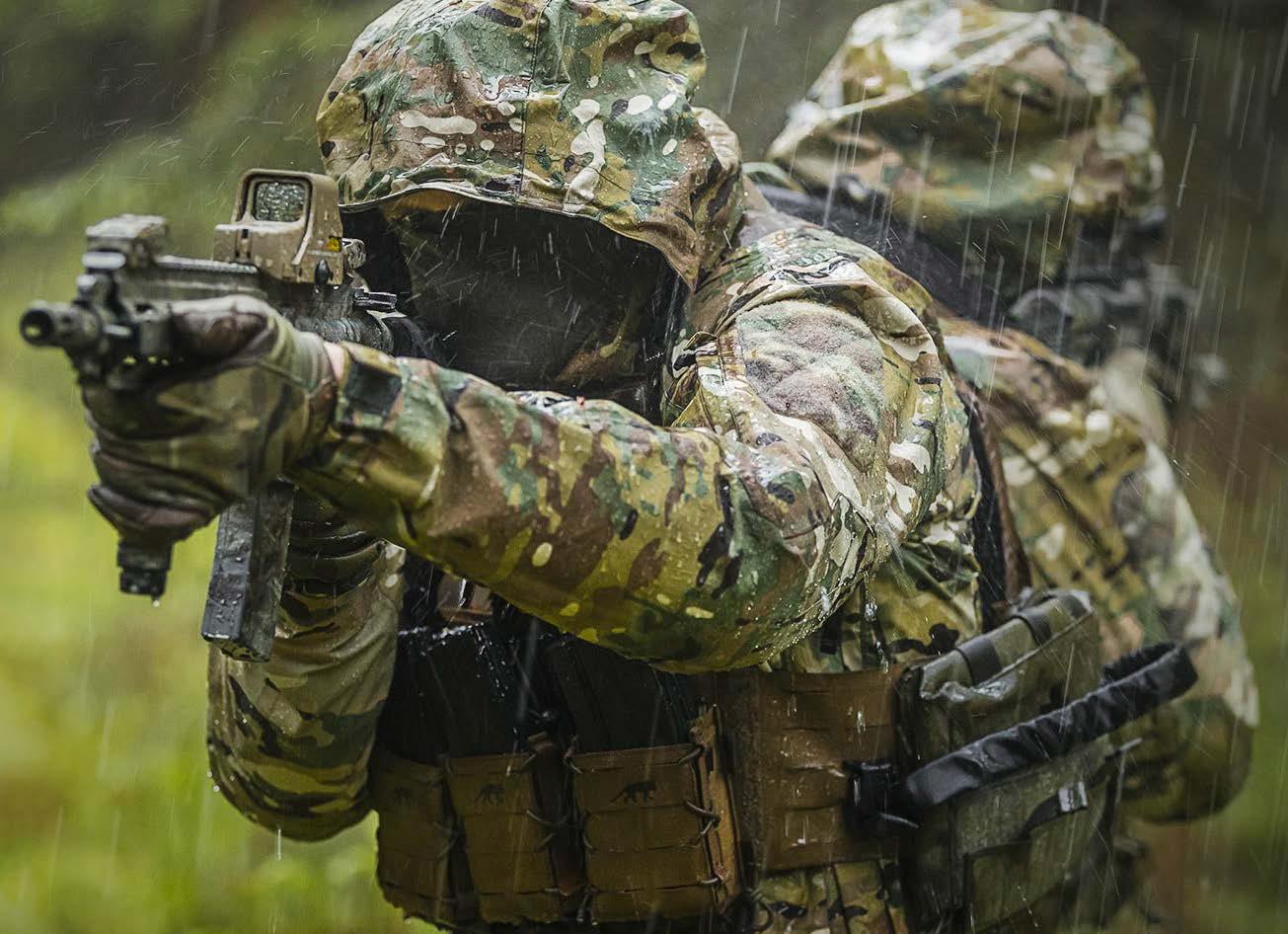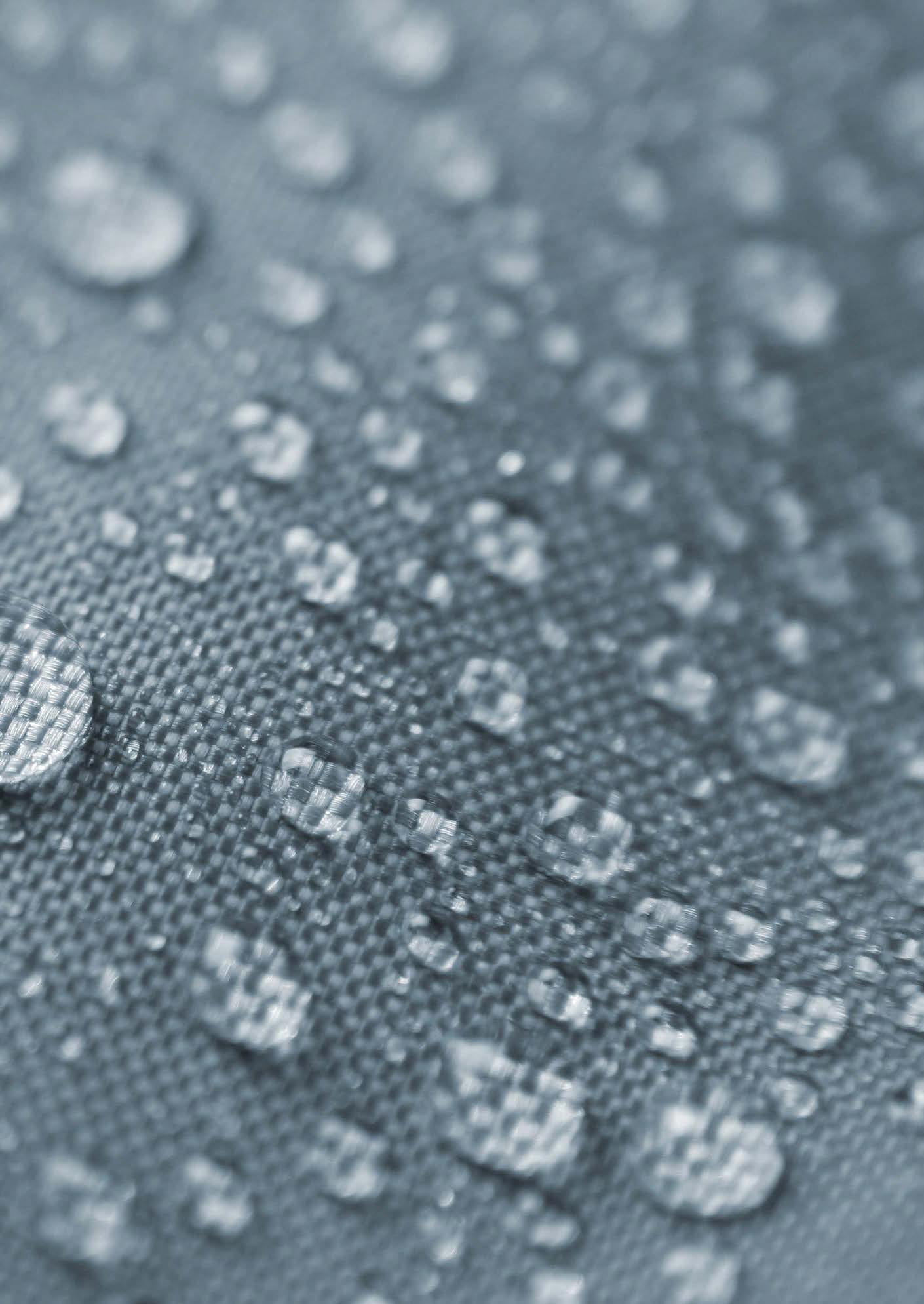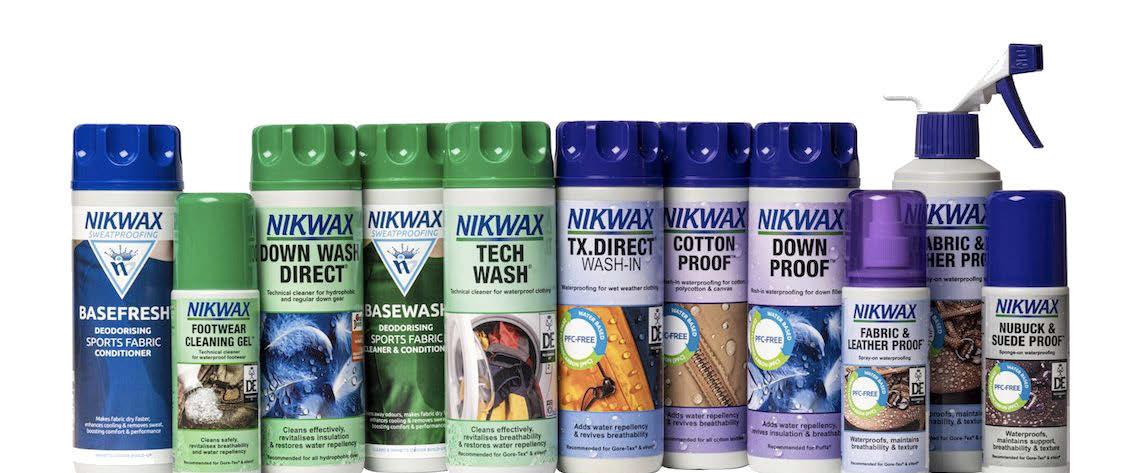
14 minute read
KIT & GEAR: TECHNICAL FABRICS
KIT & GEAR: TECHNICAL FABRIC MAINTENANCE
WITH THE MAJORITY OF US STUCK AT HOME RIGHT NOW, WE CONTINUE THIS MONTH’S LOOK AT CARE AND MAINTENANCE AS BILL REVISITS TECHNICAL FABRICS AND TAKES A CLOSE LOOK AT WHY YOU SHOULD CHOOSE THEM AS PART OF YOUR LOADOUT AND HOW YOU CAN EFFECTIVELY LOOK AFTER THEM WITHOUT LEAVING THE HOUSE! U nderstanding what you buy and what you use in relation to your personal clothing is a subject that’s very close to my heart. “Technical clothing”, whilst not hard to come by, is an expensive part of any loadout and you want it to keep on performing for a significant time to make your investment worthwhile. So, what are we really talking about when we use the phrase “technical performance fabrics”? Basically, we are looking at fabric technologies with a very specific end use in mind, that balance the three key areas of waterproofness (read general weatherproofness), breathability and durability.
I’ll use the well-known GORE-TEX products as an example here, as they really are a market leader and Gore are continually developing new, ground-breaking fabric technologies to meet the needs of their Brand partners. Breaking it down, W L Gore and Associates use two main forms of construction in their garments, Two and Three Layer (although there are other specific constructions in their massive portfolio). Two Layer construction essentially means that their ePTFE (expanded Polytetrafluoroethylene) membrane is attached directly to an outer face fabric with a loose lining; Three Layer construction means that the face fabric, membrane and inner lining fabric are all bonded together. Many prefer the Three Layer construction as it’s is easier to get on and off as a loose mesh liner can sometimes snag on gear.
Different seam tapes (to ensure seams are 100% waterproof and do not let water in through stitch holes) are used in the different constructions; Two Layer seam sealing tape is applied to the GORE-TEX membrane directly, whilst in Three Layer the sealing takes place over the inner lining fabric. Seam sealing is an art form in itself! WATERPROOF Let’s take a look first at waterproofness and how technical fabrics achieve this.
The GORE-TEX membrane is the heart of all their excellent products. It contains over 9 billion microscopic pores per square inch. These pores are 20,000 times smaller than a water droplet, but 700 times larger than a water vapor molecule, which makes the membrane durably waterproof, while allowing perspiration (moisture as a vapour) to escape from the inside. An oleophobic, or oil-hating, substance is integrated into the membrane, preventing the penetration of body oils, insect repellents and the like.
Simply put, imagine an elephant, a mouse hole and an ant! The mouse hole is the microscopic pore in the membrane, the ant is a water vapour molecule and the elephant a water droplet. It’s pretty easy to see that although the ant can escape through the mouse hole with ease, there is NO WAY that you could push the elephant through it without breaking the wall down! In garment
terms that would mean tearing a darn great hole in your jacket!
So, water cannot penetrate the membrane, or can it? Logic dictates that eventually any fabric technology can be pushed to a point of failure and this can be tested. In this case the applicable British Standard that I refer to is “BS EN 343:2003 Protective Clothing: Protection against Rain”. The Standard describes the tests that should be carried out to ascertain a garment’s level of waterproofness and sets out the performance standards that items carrying this description should meet. A Test House would carry out these tests in order to ascertain the garment’s ability to keep out water. This is measured in PSI (pounds per square inch) or “Hydrostatic Head”. Hydrostatic Head is measured in mm and pressure is measured in pounds per square inch.
The Hydrostatic Head is determined by a test whereby a fabric is held taut underneath a sealed tube of water 1 inch in diameter. Over 24 hours it is observed to see how many millimetres of water the fabric can withstand before it leaks through. When the fabric begins to seep water, the “height” in millimetres is noted. This is known as the fabric’s ‘hydrostatic head”, which literally means: Hydro - Water, Static - Not moving, Head - Height.
The PSI relates to the amount of water pressure that a garment can withstand both from the pressure within

the garment (the wearer) and the external conditions (the weather). To be 100% waterproof, the British Standards of 3PSI has to be met, which means that a fabric can withhold 1500mm of water pressure. Pressure is not just as simple as the pressure of a rainstorm, simply moving a garment when it is worn will exert pressure on the fabric.
Let’s put this in perspective though… If you were to sit on a wet, flat surface the mean pressure you generate is around 10,000mm! If you were kneeling in a firing position then the point of the knee generates 15-17,000mm of pressure (smaller surface area, greater pressure) so let’s face it, a minimum legal rating of 1500mm just does not do the job. It does begin to explain though, how a garment can be legally classed as “waterproof” but in reality it isn’t.
Back to GORE-TEX. What’s the hydrostatic head I hear you ask? Simple one this, as all GORE-TEX products have a MINIMUM testing level of 28,000mm… that’s right, 28 metres! Put another way I’ve seen top end GORE-TEX fabrics tested at over 70 PSI and not leak until they quite literally explode! Belt and braces time here folks.
BREATHABLE Comfort is a relative thing but if you’re too hot, that can lead to heat exhaustion, too cold, hypothermia; whilst keeping external ingress of moisture at bay, controlling the

micro-climate inside your clothing system helps to prevent either too. The body regulates itself effectively; as activity levels increase you sweat and the evaporation of this moisture helps to cool the skin. If moisture is not allowed to move away you will become “uncomfortable” inside your clothing system.
Letting moisture escape from the system is a tricky thing but it’s essentially what is being discussed when we use the word “breathable”. Behind it all is a law of nature: the Law of Partial Pressures. This law states that moisture as a vapour will naturally move from a warm, high pressure environment to a cooler low pressure one. If we are keeping a well-balanced temperature inside our clothing system, then on a bad-weather day moisture will move away from our skin through the pores in our clothing and escape to the outside. Sometimes we call this the “Temperature Gradient” as it sounds like moisture vapour is moving “down” from hot to cold.
So does a breathable fabric technology work in a rain forest? Yes, is the answer but due to the temperature inside the garment and outside the garment being more in equilibrium, the transfer rate will obviously slow down. We all know we can work with Ma Nature - but never beat her!
This, of course, is also subject to testing. Many methods can be used here to establish a Moisture Vapour Transmission Rate (MVTR) or a Resistance to Evaporative Transmission (RET) figure. Of the two I prefer an RET figure as it just plain makes more sense to me. Skin is 100% breathable and has an RET of Zero. As soon as you cover it though, you build up a resistance that slows down the rate at which moisture can be transmitted away; the thicker the barrier the more resistance and the slower the transmission. In essence, this means that as you cover the skin with layers your system becomes less breathable so we will always be looking for technical fabrics with as low an RET figure as possible.
In some cases the clever folks at Gore have got the RET figure well down into single figures, especially on their bespoke technologies. They continually develop completely new and innovative lining fabrics which are thinner (but more durable) than the industry standard linings available elsewhere - and thinner = less resistance, right?
WHAT YOU CAN DO IN YOUR DOWNTIME If you’re spending a lot of money on a set of waterproof gear, then you really want to get the best out of it don’t you? Just like changing tyres or the oil in a car, your “shell gear” will really, really benefit from some regular “TLC”, a bit of a service if you like. I truly believe that there is a far

better understanding of the fabric technology used in our clothing systems than ever before and it’s a subject that is a bit of a “holy grail” for me. All too often I’m out on the range or at a game with my mates and when we get back in the car their “Gucci” waterproof shell gear just gets dumped unceremoniously in a pile on the floor or in the footwell!
These are usually the self-same people that I will see at a later date bemoaning the fact that their expensive waterproof jacket “isn’t working”, complaining to all and sundry that somehow the technology has failed and that they are wet and uncomfortable. The most common gripe I hear is that “this funking thing is leaking” when actually it’s still perfectly fine and the fact is, it just isn’t “breathing” anymore!
Like all performance items, top-end shell gear needs maintaining regularly to get the best from it. You might only change the tyres on your car infrequently (probably when the MOT or insurance inspection rolls around!), but on a Formula One car they may change the tyres several times during a single race to get the very best performance.
When you buy a Gore-Tex (or similar) jacket you’re investing in a high-performance item, and as such, it needs treating like one! Over time things like the hydrophobic (water-heating) Durable Water Repellent (DWR, think a microscopic “film”) on the outer face fabric of the garment will begin to wear and crack and the fabric will start to hold the water that’s now allowed through to it. As new, water droplets will be held on the DWR layer, simply rolling off the fabric before they penetrate. You’ll notice after a while that this “beading” process will start to lessen and that the water is being absorbed into the fabric itself; this is usually noticeable first in areas like the shoulders where pack straps or a plate carrier rub and abrade the DWR, or on cuff ends where the fabric rubs against itself.
Internally over time, body oils, grease and general dirt will also build up and the net result is that your jacket will stop “breathing” as well as it did when it was new. You won’t really notice this until it becomes obvious and water vapour that was previously being transferred out of the system stays inside and re-condenses. You’ll feel cold, clammy and uncomfortable and, when you put your hand inside your jacket, feel “water” and of course your quite natural conclusion will be that the jacket is leaking!
A re-proofer will restore the waterproof performance of your gear to ensure it continues to keep you dry and protected. To combat the degradation of performance you simply need to give your jacket (or pant) a bit of care and invest in a maintenance product. There are many of them
on the market these days and most can be ordered easily online, so check out brands like Grangers, Nikwax, Storm, Red Wing, Rockin’ Green, and Gear Aid.
These brands create environmentally sustainable treatments used to clean, waterproof and care for fabrics and the majority can be used in the same wash cycle. You’ll also find bespoke products for down, merino, and base layer care products to keep all of your gear tip-top. These products offer high performance cleaning, water proofing and after-care treatments that let you refresh and restore the performance of your gear, ensuring your kit delivers the same protection it did when you bought it.
The first step is obviously to clean your garments and to do this you need to ensure that first and foremost you follow the manufacturer’s care guidance that’s given on the label you’ll no-doubt find inside the garment. Most garments, including hard shell, can be popped in the washing machine and by using a dedicated wash product you can make certain that no harm is going to come to your beloved gear so it comes out all sparkly and fresh!
Once your garment has been cleaned, you should clean out your washing machine’s detergent tray. This is a similar step for washing but you’ll want to clear out any remnants of your washing product. Get yourself some wash-in proofer (unless your garment has a hydrophilic (waterloving) lining which is used sometimes to help transfer internal moisture, in which case use a spray on proofer to the outer face as directed!) then simply follow the instructions for volume and temperature settings before setting the washer. Let the cycle run with the proofer and once completed, allow the cycle to repeat and remove excess moisture. Re-proofers usually activate with heat so if your garment allows you to tumble dry it the heat will help activate the replenished coating and then you’re good to go all over again.
All of your clothing system will benefit form a good wash and clean and again, products like base and midlayer washes will help your clothing system in its entirety. These wash products are specially formulated to work with both natural and synthetic “thermal layering and next to skin” garments to retain and improve performance and aid in effective moisture wicking, enhancing the overall effectiveness of your entire clothing system.
And if, god forbid, you do tear your jacket or pant don’t despair as most of the brands mentioned also offer a products for repair, often in the form of patches. The patches provide a simple and easy method of sealing holes

and tears, as well as providing an excellent protective solution. Most repair patches are made from tough, matte finish, abrasion resistant, elastomers that resist punctures and tearing, combined with an aggressive adhesive formulated for high bond strength. The patches expand, absorbing force on impact and always return to their original shape and size. This flexibility allows the patch to conform to irregular surfaces without restricting the movement of the repaired material.
With an emphasis on preservation and eco projects, it appears that even care product manufacturers are “going green” for the sake of the environment too! A huge 91% of discarded plastic isn’t recycled and it has been predicted that by mid-century, the oceans will contain more plastic waste than fish, ton for ton (https://news. nationalgeographic.com)! To do their bit, companies have introduced new, easily-recyclable product containers. Using plastic-free packaging, you can now buy products that are not only great for your gear, but also great for the environment.

THE BALANCING ACT
It’s always precarious balancing act when you put technologies together in a garment with a lining fabric and an outer face fabric that will ensure long term durability whilst not degrading performance and when you then add thermal mid-layers and fast-wicking baselayers it becomes trickier still! All these fabrics are chosen with extreme care and tested for all kinds of heat, cold, flex and abrasion. Not maintaining these garments to the best of your ability simply means that you’re not getting the levels of performance you have invested in and this is something you can be doing at home right now.
The fact of the matter is that many people find performance garments expensive but at the risk of being blunt, they must have no real conception of what is going on behind the scenes! When you’re paying for a performance garment you’re getting “Formula 1” levels of performance and that doesn’t come cheap. Of course, you can always buy a cheap “hatchback” but if your enjoyment, and ultimately even your life, may end up depending on the performance of your clothing system I have to ask the question “how much is too expensive”? Use your time wisely now while you have it, and get your gear prepped and ready for new airsoft adventures as soon as we’re allowed back out to play! AA










